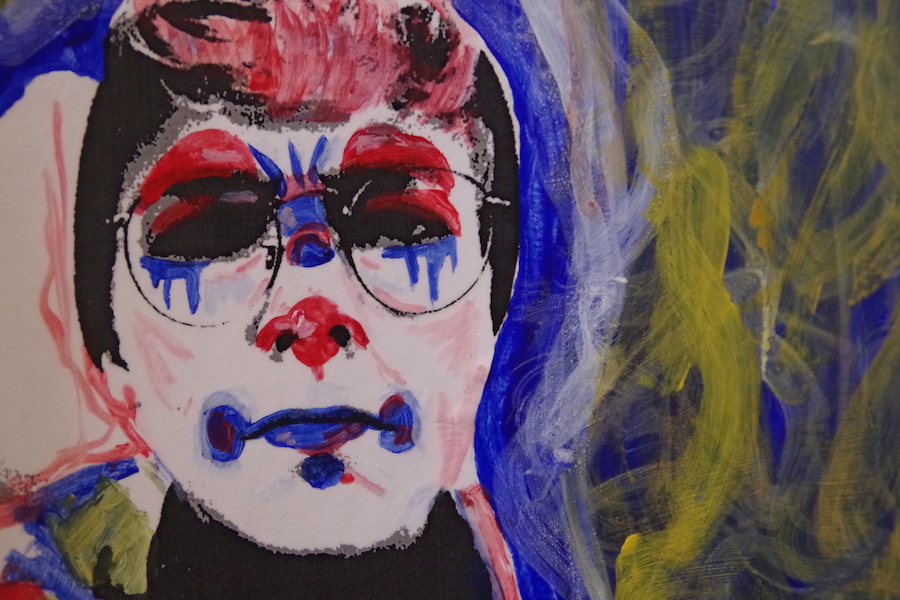
East Rock | Ely Center of Contemporary Art | Arts & Culture | Visual Arts
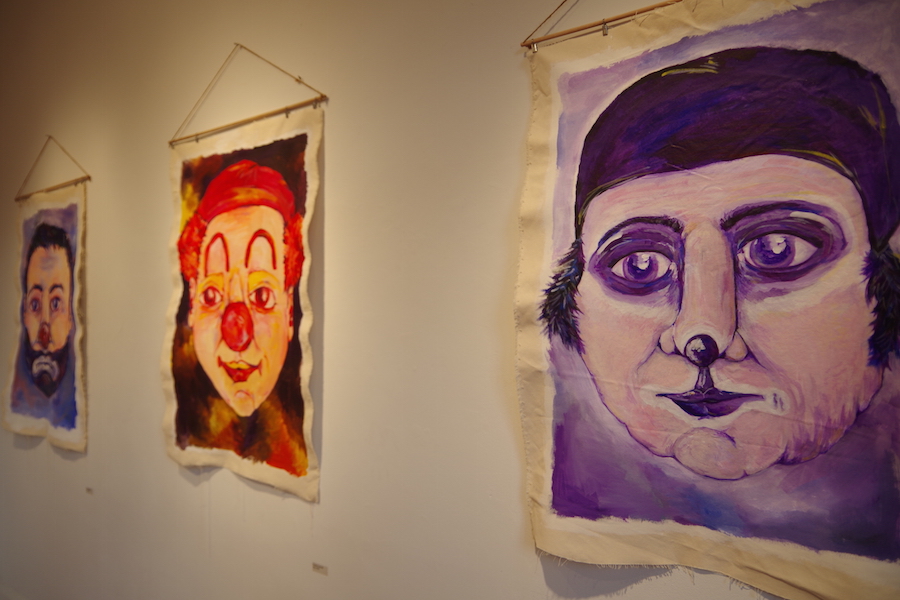
| From left to right: Maxim Schmidt's "Daniel," "Terry" and "Donovan." Leah Andelsmith Photos. |
The purple-toned portrait of “Donovan” is all about the eyes. With shining irises surrounded by deep violet shadows and ringed with white clown makeup, those eyes have a story to tell. Donovan’s hair is dark brown, with purple highlights.
But is the hair sideburns, or the ends of a short bob peeking out of a purple hat? Viewed from the left, Donovan is giving a wry half-smile—like they know more than we viewers ever will and might want to laugh at us for something.
The portrait is one of a dozen featured in Maxim Schmidt’s exhibition Gender Fools, running now through Jan. 6 at the Ely Center for Contemporary Arts (ECoCA). Schmidt’s solo show is part of a wider exhibition called A Wintry Mix: A Medley of Exhibitions and Special Projects that loosely brings together work from a group of nine, mostly Connecticut-based contemporary artists. That exhibition also closes on Jan. 6.
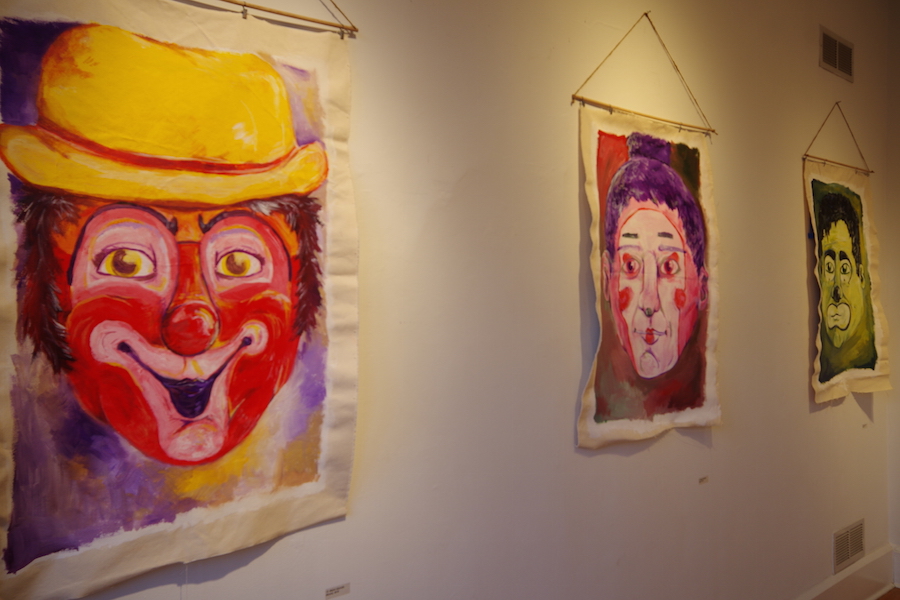
| Schmidt's "Beverly," "Logan," and "Sophia." |
Schmidt’s collection of work hangs in a bright room on the second floor of the center, where he uses the space to call attention to and interrogate gender as performance. In each portrait, the subject is painted with clown makeup: a red nose, triangles under the eyes, exaggerated brows.
“Each and every one of us puts on our own gender ‘mask,' and anxiously await how the world around us perceives us,” Schmidt writes in his artist’s statement. “We often become fools in gender, losing ourselves in the facade, and so clowns are a fitting metaphor for the performance of gender expectations.”
The portraits’ features are ambiguous when it comes to gender, and each face appears disembodied, with out a neck and shoulders to anchor it, further cutting the viewer off from clues about the face’s gender. After painting, Schmidt randomly assigned a name to each portrait.

| "Daniel." |
“Logan” is like a sprite with high cheekbones and a narrow chin. Their purple hair is up in a high bun and their face is painted in reds and pinks and whites. Logan’s natural eyebrows are relaxed, lending a calmness to their face. But at the same time, their painted clown brows are lifted high in surprise. There’s a happy playfulness to this portrait.
“Daniel’s” eyes are so sad and their mouth is a clown’s frown painted on top of a beard that seems smooth and plasticky like a mask. “Sophia” (pictured below) looks overwhelmed, puffing their cheeks out in exasperation. “Terry” is bright red and yellow, and they appear to emerge from a dark background, like a memory resurfacing. Over soft over round cheeks, their eyes are big and childlike, yet weary with time or age.
“We often break people down to their outward expression, making binary assumptions about their identity based upon superficial appearances,” Schmidt says in his statement.
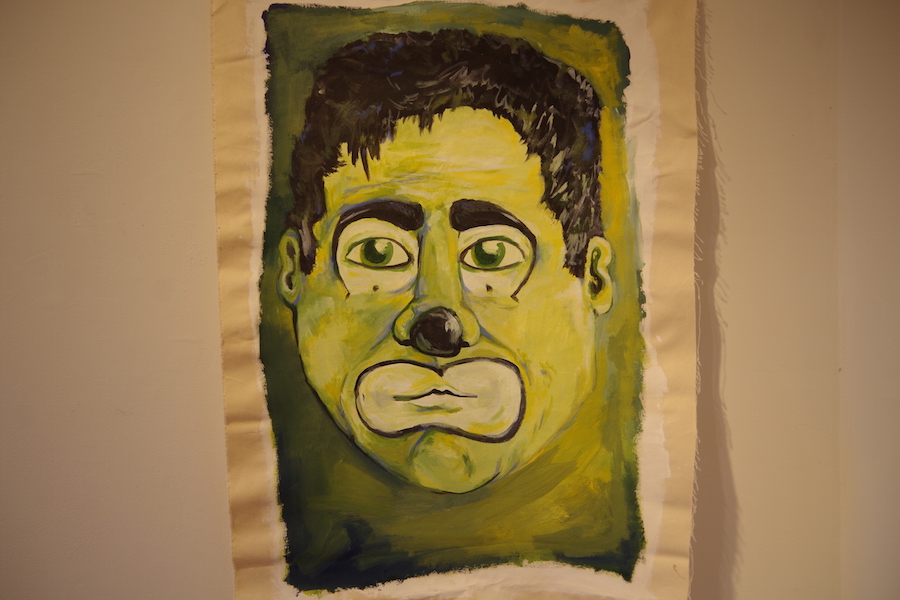
In these portraits, there is no clear sense of gender, and so the viewer’s attention turns to the face itself. Without a convenient way to categorize each person, the story behind the face becomes the focus. Do they smile in friendliness or to cope with some unnamed pain?
Of all the clowns, “Beverly” is the most made up, with red, pink and orange face paint topped with a sunny yellow hat. The addition of purple lips and hair makes an anxious combination that won’t let the viewers’ eyes be still. But Beverly’s face is mischievous and happy.
They look like the kind of person who is positive through all kinds of adversity and who tends to land on their feet. Their eyes are focused just to the left of the viewer, like theres’ something funny or inspiring in the distance. They’re distracted, but you can’t expect their attention on you all the time. They’re just that kind of person.
ECoCA Gallery Coordinator and Curatorial Assistant Sophy Johnston suggested that traditional notions of binary gender expression and the expectations based on gender are at the center of Schmidt’s work. “He’s de-stabilizing all of that,” she said in a recent interview. “There are no expectations anymore. We’re all just bodies.”

| A detail from "Refaced #4." |
An undergraduate student at Albertus Magnus College, Schmidt said his work has always been very personal. He was drawn to clowns as performative art and the way makeup is used both to conceal and to express a sense of self. But after making the portraits in Gender Fools, Schmidt said he “felt I was a little too removed from my concept.”
So Schmidt made Refaced, a set of six self-portraits that spills into the hallway adjacent to his exhibition room at ECoCA. The artist xeroxed six dissimilar photos of himself and manipulated the images, painting over his face with clown makeup. The expressions in the photographs range from happy to neutral to hostile, but the forced joviality of the clown makeup is laid atop, and the effect is jarring.
“Refaced #1,” is bleak, with Schmidt’s startled expression and the way the figure is pushed into the corner of the frame with a chaotic swirling colors of the background closing in. But in “Refaced #2,” Schmidt wears a smirky smile, and appears to have pulled one over on us. You haven’t figured out yet that it’s all a construct? he seems to be saying.
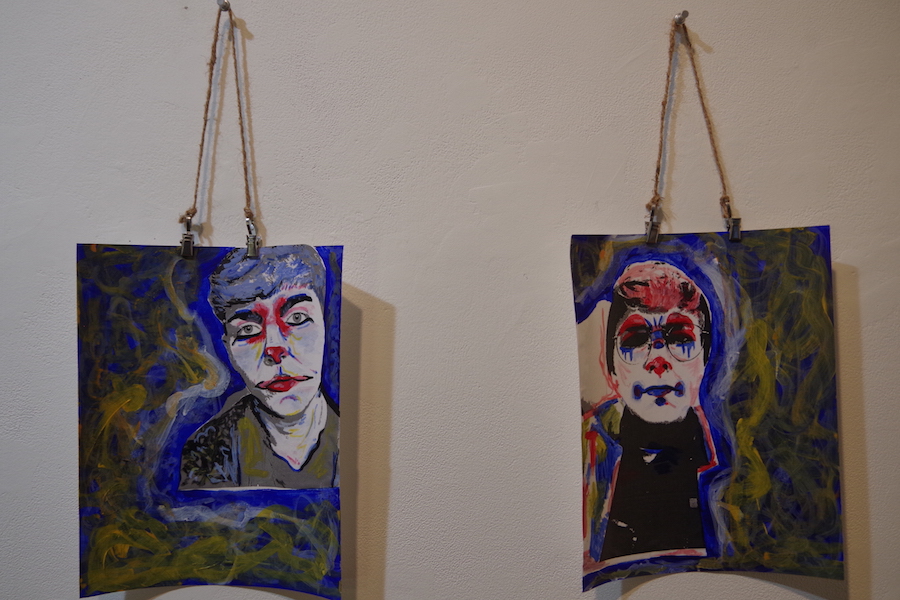
| "Refaced" numbers three and four. |
The image is comfortably centered in the composition, and the muddled lines and colors of the background don’t appear to be crowding it out. In“Refaced #3” Schmidt appears defiant. There’s some despair in his eyes, but also the hint of a posturing shrug. The clown eyebrows are drawn thick and tight over the eyes, so there is anger too, leaving the viewer to wonder whether he’s ready to revolt or self-destruct.
In each image, it’s as if Schmidt finds a new way to cope with the weight of gender expectations. Sometimes the burden is light, sometimes it’s crushing.
As a trans person, Schmidt said it was important for him to make a more personal expression of his concept for Gender Fools.
“It’s a way of confronting myself with the same topic, in the same way I wanted to confront my audience,” he said in a recent phone interview. “If I wanted my audience to be vulnerable, I wanted to put myself on the same vulnerable platform.”
In the room adjacent to Schmidt’s is The Spaces in Between, a solo show by Briah Luckey. It’s work of an entirely different feel: monotypes of organic materials hand printed by the New Haven-based artist.
.jpg)
| Briah Luckey's Sunset, 2018. |
Prints of leaves, flowers and seaweed overlap, like impressions left in mud or the outline of wet leaves on pavement. The leaves’ veins are delicate and intertwined, and in the negative space around them, Luckey has traced their shape with curved lines in pink or gold.
“Summer Leaves with Pink,” the largest work in the room, is printed from a fragment of a tablecloth. The cloth is finished on two sides, but ripped and frayed on the others. The informal, unfinished quality adds to the sense that the work is a fossil, a permanent record of objects that just happened to fall in this way, like leaves that float down to cover the lawn.
“Hydrangea Vail” is dreamlike, with prints of flowers that look like butterflies and washes of blue, pink, and coral printed on a gauzy handkerchief or napkin. And in “Sunset,” Luckey added a sparkle to the layers of teal, coral, apricot, and deep eggplant printed on a doily or placemat. It’s easy to picture the leaves drifting onto an unused table while the pigments collected around them like dust.
.jpg)
Luckey sources her vintage linens from estate sales and flea markets, and for Johnston, it’s an important part of the work. “She’s using these reclaimed fibers that, at least in the past, have always been in the context of women. Women used these. Women created these. I find her work to be incredibly feminist.”
Luckey’s art has developed out of her work as an art therapist and workshop leader. “I imagine a lot of her work has shifted as a result of what she does in her workshops,” said Gallery Director Debbie Hesse. “It’s a different way to share yourself as an artist and community leader, and she’s just kind of found her voice from doing projects and workshops.”
Luckey is “not process-heavy,” added Johnston. “She’s more concerned with getting into the meditative aspects of the art.”
.jpg)
| Shilo Ratner's "Fathomless." |
Downstairs, New Haven artist Shilo Ratner flirts with the figurative in her series of abstracted landscapes. But her work is still rooted in the language of form, color and composition. In many of her paintings, Ratner places the ocean center stage. Land and sky are condensed into one tiny strip, a reference point at most. In contrast, the water itself fills the frame with colors that vibrate and radiate emotional depth.
In “Blue Depth,” the horizon and sky are just a thin border, while the depth and movement of the water fill the canvas. The water is composed of overlapping shapes—triangles, parallelograms, and trapezoids, all in different colors and textures. In some shapes, the brush strokes are like gouache.
Others are softly colored, like worn denim. Some are a vibrant blue that appears dark and light at the same time. Some are an opaque navy, like a banker’s suit. There are sharp angles that reference sea-faring birds, or the waves and swells of the water. The shapes flatten into stripes towards the horizons, and the sky is one flat, bland light blue band at the top.
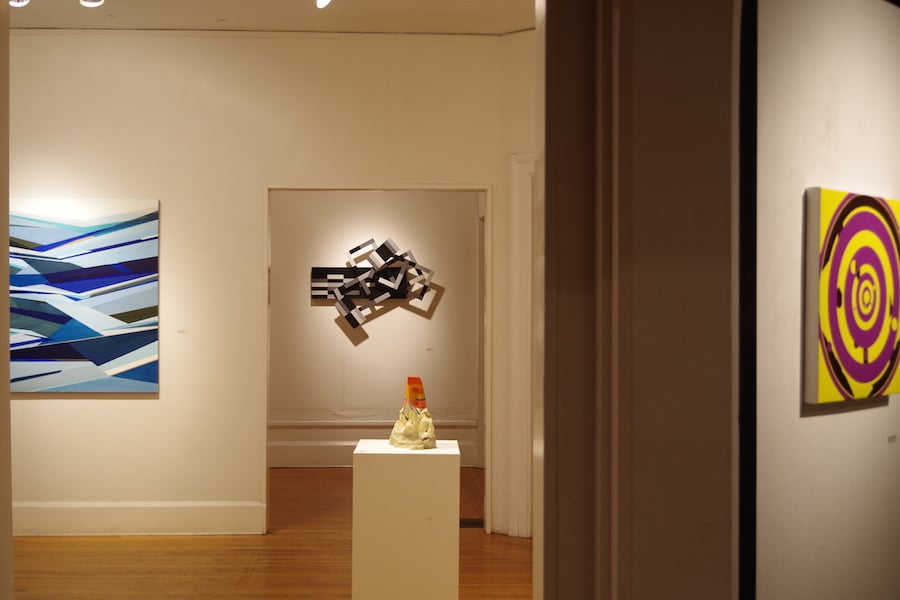 In “Fathomless,” the ocean is swelling and rolling, as if in high wind. The scene can be intuited through the movement of the shapes and colors, even though the waves are fractal, pixelated. Ratner has broken the form, but left the essence intact.
In “Fathomless,” the ocean is swelling and rolling, as if in high wind. The scene can be intuited through the movement of the shapes and colors, even though the waves are fractal, pixelated. Ratner has broken the form, but left the essence intact.
Work from mostly-local artists Bob Gregson, Ken Lovell, Laura Moriarty, and Benjamin Parker is interspersed with Ratner’s. The art is spread across four rooms and mixed in with each other, giving a uniform feel to this “themeless” exhibit, and it ranges from Moriarty’s dream-like beeswax sculptures to Parker’s intricate, geometric origami. But whether the artists’ images are soft and flowing or bold and angular, each piece takes several steps back from the world of the figurative, letting line, color, form and shape take the lead.
Briah Luckey will be teaching a hands-on Monotype Plant Prints on Fabric workshop on Dec. 19th from 1-4 pm. Advance registration accepted through Dec. 15. Tickets are $45 per person and include materials.

